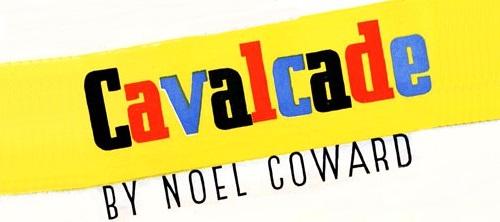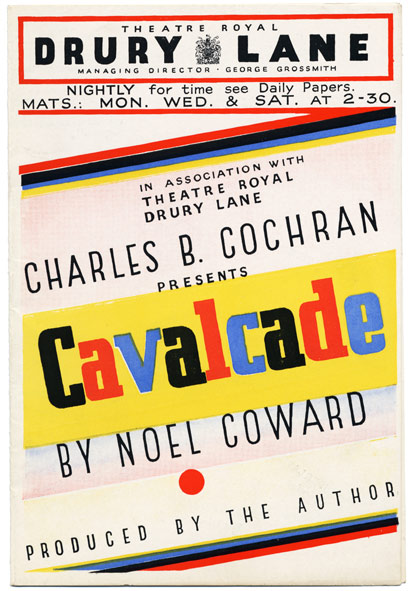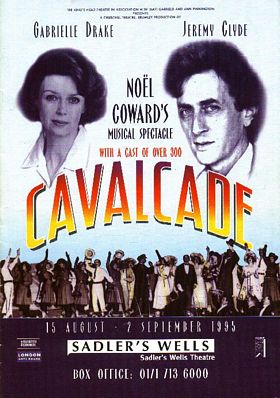Cavalcade
Musical (1931)

Coward began researching the project while appearing in the Broadway production of Private Lives, finding inspiration in back issues of The Illustrated London News he had brought to New York City with him expressly for that purpose. He also drew on his personal memories for many of the twenty-two scenes in the three-act play.
After returning to London, Coward continued to work on the play. Knowing the size and scope of the project would require as large a venue as possible, he and designer Gladys Calthrop inspected Theatre Royal, Drury Lane and found it to be ideal due to the depth of the stage, the width and height of the proscenium, the various lighting and flying effects that could be achieved, and the six hydraulic lifts that could be utilized to move scenery easily. While Calthrop began the task of designing hundreds of costumes and dozens of sets, Coward worked on the script, which he completed in August 1931. Rehearsals began the following month.
With four hundred cast and crew members involved in the production, Coward divided the crowd into groups of twenty and assigned each a leader. Because remembering individual names would be impossible, everyone was given a color and number for easy identification, thus allowing Coward to direct "#7 red" to cross downstage and shake hands with "#15 yellow and black." Extras were encouraged to create their own bits of stage business, as long as it didn't draw focus from the primary action of the scene.
Cavalcade premiered on 13 October 1931, starring Mary Clare and Edward Sinclair as the Marryot parents and featuring John Mills, Binnie Barnes, Una O'Connor, Moya Nugent, Arthur Macrae, Irene Brown and Maidie Andrews in supporting roles. Despite a brief delay caused by a mechanical problem early in the first act, the performance was a strong success, and the play went on to become one of the year's biggest West End hits, running for 405 performances. The play closed in September 1932.
Opening just prior to the British General Election, the play's strongly patriotic themes were credited by the Conservative Party for helping them secure a large percentage of the middle class votes, despite the fact Coward had conceived the project a full year before the election was held, and the playwright strenuously denied having any motivation to influence its outcome. King George V and Queen Mary attended the performance on election night and received Coward in the Royal Box during the second interval.
Owing to the size and sheer cost of production, Cavalcade has not been staged on the scale of its original production. The few revivals have trimmed a number of the more spectacular scenes, in particular the finale with its multiple lighting and sound effects depicting industrial and social chaos.
This epic production covers three decades in the life of the Marryott family and their servants, starting in 1900 and ending on New Year’s Eve, 1929. The family is caught up in such events as the Relief of Mafeking, the death of Queen Victoria, the sinking of the Titanic and World War I. Popular songs of at the time of each event were interwoven into the score, which also included original music by Noel Coward.
Afficher le synopsis détaillé
Part I
Scene 1: Sunday 31 December 1899. The drawing-room of a London House
It is nearly midnight. Robert and Jane Marryot are seeing in the New Year quietly together in their London house. Their happiness is clouded by the Boer War: Jane's brother is besieged in Mafeking, and Robert himself will shortly be going to South Africa. Robert and Jane invited their butler, Bridges, and his wife, Ellen, to join them. Bells, shouting, and sirens outside usher in the New Year, and Robert proposes a toast to 1900. Hearing her two boys stirring upstairs, Jane runs up to see after them, and her husband calls to her to bring them down to join the adults.
Scene 2: Saturday 27 January 1900. A dockside
A month later, a contingent of volunteers are leaving for the war. On the dockside Jane and Ellen are seeing off Robert and Bridges. As the men go aboard, Jane comforts Ellen, who is crying. A band strikes up "Soldiers of the Queen". The volunteers wave their farewells to the cheering crowd.
Scene 3: Friday 8 March 1900. The drawing-room of the Marryots' house
The Marryot boys, Edward, aged twelve, and Joe, aged eight, are playing soldiers with a young friend, Edith Harris. She objects to being made to play "the Boers", and they begin to quarrel. The noise brings in their mothers. Joe throws a toy at Edith, and is sharply slapped by Jane, whose nerves are on edge with anxiety about her brother and her husband. Her state of mind is not helped by a barrel-organ outside, playing "Soldiers of the Queen" under the window. Margaret, Edith's mother, sends the organ-grinder away and proposes to take Jane to the theatre to take her mind off her worry.
Scene 4: Friday 8 May 1900. A theatre
Jane and Margaret are in a stage-box, watching MirabeIle, the currently popular musical comedy. The plot is the usual froth, but the denouement is not reached: the theatre manager comes onstage to announce that Mafeking has been relieved. Joyous uproar breaks out; the audience claps and cheers and some begin to sing "Auld Lang Syne".
Scene 5: Monday 21 January 1901. The kitchen of the Marryots' house
The cook, the parlourmaid, Annie, and Ellen's mother, Mrs Snapper, are preparing a special tea to greet Bridges on his return from the war. He comes in with Ellen, looking well, and kisses his little baby, Fanny. He tells them that he has bought a public house so that he and Ellen can work for themselves in future. The celebratory mood is dampened when Annie brings in a newspaper reporting that Queen Victoria is dying.
Scene 6: Sunday 27 January 1901. Kensington Gardens
This scene is all in mime. Robert and Jane are walking in Kensington Gardens with their children when they meet Margaret and Edith Harris. Everyone is in black, solemn and silent, following the Queen's death.
Scene 7: Saturday 2 February 1901. The Marryots' drawing-room
On the balcony, Jane, Margaret, their children and the servants are watching Queen Victoria's funeral procession. Robert, who has won the Victoria Cross is walking in the procession, and Jane has some difficulty in making her boys suppress their excitement and pay due respect as the coffin passes. As the lights fade, Joe comments, "She must have been a very little lady ".
Scene 8: Thursday 14 May 1903. The grand staircase of a London house
Jane and Robert are attending a grand ball given by the Duchess of Churt. The Major-domo announces, "Sir Robert and Lady Marryot".
Part II
Scene I: Saturday 16 June 1906. The bar parlour of a London public house
Jane has brought her son Edward, now eighteen, to see Ellen in the flat above the public house. They have just finished tea, together with Flo and George, relations of the Bridges. Seven-year-old Fanny has been dancing to entertain them. Bridges enters, clearly drunk. Jane, dismayed, makes a tactful departure. Bridges starts to bully Fanny and is ejected from the room by George and Flo.
Scene 2: Saturday 16 June 1906. A London street (exterior of the public house)
After emerging from the pub, Bridges carries on up the road. He is knocked down and killed by a car.
Scene 3: Wednesday 10 March 1909. The private room of a London restaurant
Edward Marryot is holding his twenty-first birthday party, with many smart young guests. Rose, an actress from the old Mirabelle production, proposes his health and sings the big waltz number from the show.
Scene 4: Monday 25 July 1910. The beach of a popular seaside resort
A concert party of six "Uncles" is performing in a bandstand. Ellen and her family are there and Fanny wins a prize for a song and dance competition. They unexpectedly meet Margaret, Jane and Joe. Ellen tells them that she has kept on the pub since her husband's death and that Fanny is now at a dancing-school and determined to go on the stage.
Scene 5: Sunday 14 April 1912. The deck of an Atlantic liner
Edward has married Edith Harris, and they are on their honeymoon. They speculate blithely how long the initial bliss of marriage will last. As they walk off, she lifts her cloak from where it has been draped on the ship rail, revealing the name Titanic on a lifebelt. The lights fade into complete darkness; the orchestra plays "Nearer, My God, to Thee " very quietly.
Scene 6: Tuesday 4 August 1914. The Marryots' drawing-room
War has been declared. Robert and Joe are keen to join the army. Jane is horrified, and refuses to indulge in the jingoisim she sees around her.
Scene 7: 1914–1915–1916–1917–1918. Marching
Soldiers are seen endlessly marching. The orchestra plays songs of the First World War.
Scene 8: Tuesday 22 October 1918. A restaurant
Joe and Fanny – now a rising young actress – are dining in a West End restaurant. Joe is in army officer's uniform. He is on leave but is about to return to the Front. They discuss marriage, but she envisages opposition from his family, and bids him wait until he is back from the war for good.
Scene 9: Tuesday 22 October 1918. A railway station
Jane sees Joe off at the railway station. Like many of the women on the platform she is distressed.
Scene 10: Monday 11 November 1918. The Marryots' drawing-room
Ellen visits Jane, having found out that Joe is emotionally involved with her daughter. The two mothers fall out: Ellen thinks Jane regards Fanny as beneath Joe socially. As Ellen is leaving, the maid brings in a telegram. Jane opens it and tells Ellen. "You needn't worry about Fanny and Joe any more, Ellen. He won't be able to come back at all, because he's dead."
Scene 11: Monday 11 November 1918. Trafalgar Square
Surrounded by the frantic revelry of Armistice Night, Jane is walking, dazed, through Trafalgar Square. With tears streaming down her face, she cheers wildly and waves a rattle, while the band plays "Land of Hope and Glory ".
Part III
Scene 1: Tuesday 31 December 1929. The Marryot's drawing room
Margaret and Jane, both now elderly, are sitting by the fire. Margaret leaves, after wishing a happy New Year to Jane and Robert, who has come in to drink a New Year toast with his wife. Jane drinks first to him and then to England: "The hope that one day this country of ours, which we love so much, will find dignity and greatness, and peace again".
Scene 2: Evening, 1930. A night club
Robert, Jane, Margaret, Ellen, and the full company are in a night club. At the piano, Fanny sings "Twentieth Century Blues", and after the song everyone dances.
Scene 3: Chaos
The lights fade, and a chaotic succession of images representative of life in 1929 is spotlighted. When the noise and confusion reach a climax the stage suddenly fades into darkness and silence. At the back a Union Jack glows through the darkness. The scene ends with the lights coming up on the massed company singing "God Save the King".
Aucun dossier informatif complémentaire concernant Cavalcade
Aucun dossier informatif complémentaire concernant Cavalcade

Version 1
Cavalcade (1931-10-Drury Lane-London)
Type de série: OriginalThéâtre: Drury Lane Theatre (Londres - Angleterre)
Durée : 11 mois Nombre : 405 représentationsPremière Preview : 13 October 1931
Première: 13 October 1931
Dernière: 10 September 1932Mise en scène : Noël Coward • Chorégraphie : Producteur : Star(s) : Avec: Mary Clare (Jane Marryot), Edward Sinclair (Robert Marryot), Una O'Connor (Ellen Bridges), Fred Groves (Alfred Bridges), Irene Browne (Margaret Harris), Alison Leggatt (Edith Harris), Arthur Macrae (Edward Marryot), John Mills (Joe Marryot), Binnie Barnes (Fanny Bridges), Veronica Vanderlyn (Edith)

Version 2
Cavalcade (1995-08-Sadler's Wells Theatre-London)
Type de série: RevivalThéâtre: Sadler's Wells (Londres - Angleterre) Salle : TheatreDurée : 2 semaines Nombre : Première Preview : 16 August 1995
Première: 16 August 1995
Dernière: 02 September 1995Mise en scène : Dan Crawford • Chorégraphie : Elizabeth Blake • Producteur : Star(s) : Avec: Gabrielle Drake (Jane Marryott), Jeremy Clyde (Robert Marryott), Nicky Goldie (Mrs Bridges), Scott Morgan (Alfred Bridges), Rosalind Bailey, Lisa Bowerman, Steffan Boje, Jon Peterson, Caroline Oliver, Penelope Woodman, Ian McLarnon, Siv Klynderud, Virginia Courtney, Terri Lewis, Nigel DenhamCommentaires : The original premiere in 1931 at Drury Lane involved great spectacle, massive sets and a professional cast of over 200 including Mary Claire, Edward Sinclair, John Mills, Irene Browne, Una O’Connor, Arthur McCrae and Moyra Nugent. The show was very successful and ran for almost a year. Because of its size and enormous production costs, it has never been revived on anything like its original scale. The work provided the idea for the 1970s television series “Upstairs Downstairs”.
This revival had started at Bromley and was part of an extensive UK tour. In each city the basic professional cast of 15 people would be augmented by hundreds of local amateurs and a large number of children, with several teams of children in each venue because of licensing restrictions. It required an extremely complex system of rehearsals dealing with the ever-changing cast of supernumaries. The Sadler’s Wells production used 275 extras.
Pas encore de video disponible pour ce spectacle